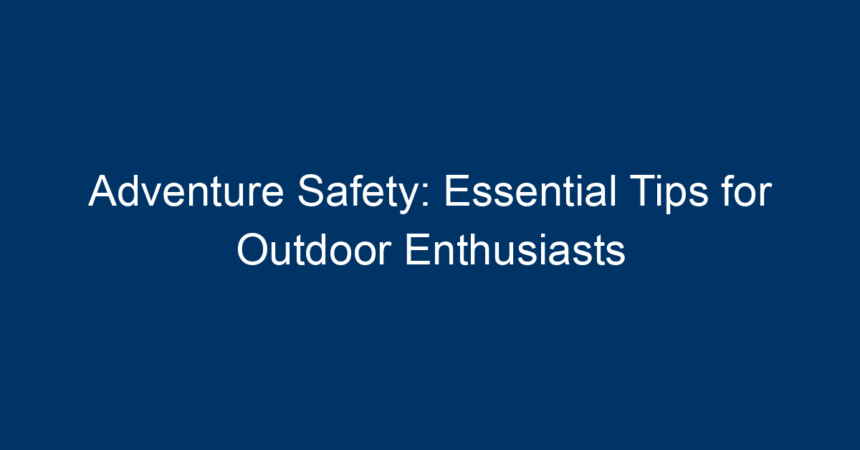Adventure awaits in the great outdoors, promising exhilarating experiences and breathtaking landscapes. Whether you’re hiking rugged trails, kayaking through fast currents, or camping under the stars, embracing nature comes with its share of risks. That’s where adventure safety comes into play.
Understanding the importance of safety measures while pursuing outdoor adventures can transform a thrilling experience into a memorable and secure one. In this article, we’ll delve into essential safety tips for outdoor enthusiasts, ensuring your next adventure remains exciting yet safe.
Understanding Adventure Safety
Before we dive into the specifics, it’s vital to comprehend what adventure safety entails. Adventure safety includes all measures taken to minimize risks associated with outdoor activities. It encompasses planning, preparation, equipment checks, and knowledge of environmental factors.
Importance of Adventure Safety
-
Prevention of Accidents: The most apparent benefit of adventure safety is the prevention of accidents. Awareness and proactive planning can significantly reduce risks.
-
Preparedness for Emergencies: Knowing how to respond in unforeseen situations is integral to adventure safety. Proper training and resources can be life-saving.
- Enhancement of Enjoyment: When you feel safe and prepared, you can fully immerse yourself in the experience without constant worry. This enhances the overall enjoyment of your adventure.
Essential Tips for Safety in the Great Outdoors
Now, let’s explore some practical safety tips that every outdoor enthusiast should heed.
1. Plan Ahead
The first step in ensuring adventure safety is thorough planning. Here’s what to consider:
-
Research Your Destination: Study maps, trails, and any potential hazards such as wildlife or challenging terrain.
-
Check Weather Conditions: Weather can change rapidly in outdoor environments. Always check forecasts and prepare for sudden shifts in conditions.
- Set a Timeline: Establish a clear timeline for your adventure. Inform someone about your itinerary and expected return time.
2. Gear Up Wisely
Having the right gear is crucial for adventure safety. Here’s what to focus on:
-
Wear Appropriate Clothing: Layering is key in outdoor activities. Choose moisture-wicking, insulating, and weather-resistant fabrics based on the environment.
-
Invest in Quality Equipment: Reliable gear such as backpacks, tents, and navigation tools can make a significant difference. Look for items that are durable and suited to your planned activities.
- First Aid Kit: Always carry a well-stocked first aid kit. Familiarize yourself with its contents and learn basic first aid skills.
3. Know Your Limits
Understanding your physical and mental limits is crucial for adventure safety:
-
Assess Your Skill Level: Choose activities that match your experience. Don’t push yourself into situations beyond your capability.
- Listen to Your Body: If you experience fatigue or discomfort, take a break. Ignoring your body’s signals can lead to injuries.
4. Use Technology Wisely
While being in nature is often about disconnecting, technology can play a pivotal role in adventure safety:
-
Navigation Apps: Utilize GPS and mapping applications to stay oriented.
- Emergency Communication Devices: Carry portable charged devices or satellite phones in areas without cell coverage.
5. Stay Hydrated and Nourished
Proper nutrition and hydration are often overlooked aspects of adventure safety:
-
Pack Enough Water: Dehydration can impair decision-making and physical performance. Always bring sufficient water and consider water filtration systems for longer trips.
- Bring High-Energy Snacks: Nutrient-dense snacks like nuts, energy bars, and dried fruits can keep your energy levels balanced during strenuous activities.
6. Be Aware of Wildlife
Interactions with wildlife can pose risks:
-
Know Animal Behavior: Familiarize yourself with the local wildlife and know how to behave if encounters occur. For example, understanding bear safety can prevent dangerous situations.
- Store Food Properly: Use bear-proof canisters or hang food out of reach in trees to avoid attracting wildlife to your campsite.
7. Practice Environmental Stewardship
Part of adventure safety involves caring for the environment:
-
Follow "Leave No Trace" Principles: Minimize your impact on nature by packing out what you pack in and camping on durable surfaces.
- Respect Wildlife and Habitats: Stay on marked trails and avoid disturbing local flora and fauna. This promotes safety for both you and the ecosystem.
Handling Emergencies: Be Prepared
No matter how careful you are, emergencies can happen. It’s crucial to be prepared.
1. Create an Emergency Plan
Develop a comprehensive emergency plan that includes:
-
Escape Routes: Know the fastest ways back to civilization.
- Emergency Contacts: Keep a list of emergency contacts and share it with family and friends.
2. Utilize First Aid Skills
Equip yourself with basic first aid skills. Knowing how to treat common injuries or illnesses can make a significant difference in emergency situations. Consider taking a wilderness first aid course to deepen your knowledge.
3. Stay Calm
In the event of an emergency, staying calm is critical. Panic can cloud judgment and lead to poor decisions. Take deep breaths, assess the situation, and make logical decisions.
Conclusion: Adventure Safety Is Non-Negotiable
Adventure safety should never be an afterthought. By taking proactive steps in planning, preparation, and awareness, outdoor enthusiasts can significantly reduce risks and enhance their overall experience. Always remember that adventure is about enjoying the moments spent in nature, and safety ensures that those moments can continue for years to come.
So, whether you’re scaling mountain peaks or navigating through dense forests, never underestimate the value of adventure safety. Carry these essential tips with you, and let them guide you to a secure and thrilling outdoor journey.
Actionable Insights
-
Plan Your Next Adventure: Create a detailed plan, considering physical limits and environmental factors.
-
Invest in Quality Gear: Prioritize durable and suitable equipment for your planned activities.
- Educate Yourself: Take first aid courses and familiarize yourself with wildlife safety.
Remember: Safety first, adventure second — because the best outdoor experiences are those where everyone returns home safely to tell the tale. Happy adventuring!




